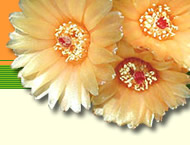|
|
ROD GYMNOCALYCIUM
PODROD V. -
MUSCOSEMINEUM Schütz
Gymnocalycium tudae Y. Ito
Explanatory Diagram 175, 1957
Tento druh je podobný Gymn. megatae. Tělo je více terčovité, 6 cm vysoké, 17 cm v průměru, sametově modrozelené, s 9 – 13 žebry; hrbolce delší a zašpičatělé.
Okrajové trny 5 – 7, na špici poněkud háčkovité; mladé trny černohnědé, na základně světle žlutozelené, na špičce tmavě hnědé.
Květ je menší, 4 cm dlouhý a 4 cm v průměru, nálevkovitý, trubka holá, zesílená, slámové barvy; vnitřní okvětní lístky bílé, vnější se světle zeleným středním proužkem, světle zelenou špičkou a tmavě červenou tečkou.
Domovina: Paraguay.
Rozdíly oproti Gymn. megatae jsou zcela zanedbatelné, pokud vůbec nějaké existují. Většina cestovatelů označuje svoje nálezy z Paraguaye jako Gymn. megatae, jako Gymn. tudae pak nálezy z Bolívie, od Boyuibe. Odtud také Ritter popsal v Kakteen in Südamerika Gymn. tudae var. bolivianum, tento popis je však zbytečný. Rostliny na nalezišti dosahují až 25 cm v průměru. Ritter původně rostliny označoval Gymn. brevistylum FR 1133, tedy s krátkou čnělkou. O něco menší květ a jeho části by měly být jakýs-takýs rozdíl oproti Gymn. megatae. Další nálezy: M 106 Boyuibe, KK 830 Palos Blancos, Lau 371 Guanacos, Lau 374 Charaqua, Lau 396 Boyuibe.
Gymn. tudae var. viridis Donald nom. nud. = Gymn. hamatum – viz pod tímto taxonem.
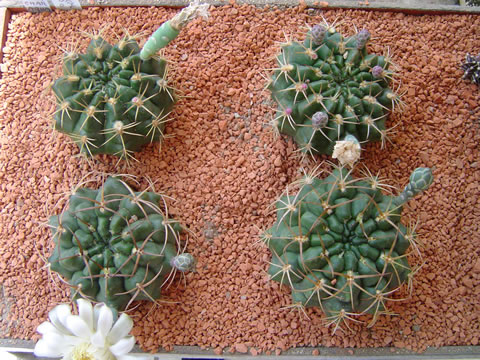
Gymnocalycium tudae
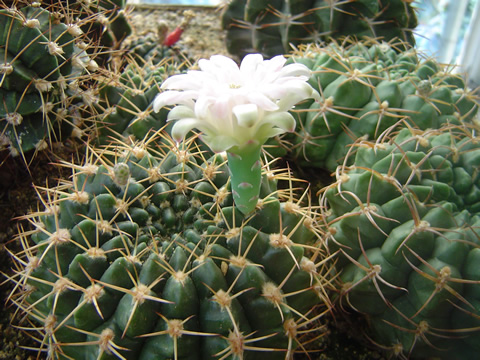
Gymnocalycium tudae Lau 374 Charaqua, foto Markéta Miltová Gymn. tudae – summary:
The differences with Gymn. megatae are quite worthless, if any. The most of travellers marks their finds from Paraguay as Gymn. megatae, then the finds from Bolivia, Boyuibe, as Gymn. tudae. Ritter has described in Kakteen in Südamerika from these areas Gymn. tudae var. bolivianum, however, the description is useless. The plants can reach to 25 cm in diameter on the finding place. Ritter had originally marked the plants like Gymn. brevistylum FR 1133, so with short style. Some littler flower and its parts should be so called difference from Gymn. megatae. The other finds: M 106 Boyuibe, KK 830 Palos Blancos, Lau 371 Guanacos, Lau 374 Charaqua, Lau 396 Boyuibe.
Gymn. tudae var. viridis Donald nom. nud. = Gymn. hamatum – see there.
Gymnocalycium onychacanthum Y. Ito
Explanatory Diagram 175, 1957
Tělo terčovité, 10 – 20 cm v průměru, modrozelené. Žebra 13 – 20, rozdělená v hrbolce tvaru podkovy.
Okrajové trny 7 – 9, šídlovité, asi 3 cm dlouhé, hřebenovitě uspořádané, modré, s tmavě žlutou základnou, později popelavě šedé nebo barvy myší šedi.
Květ zvonkovitě nálevkovitý, asi 2,5 cm dlouhý a 3 cm široký. trubka úzká, krátká, válcovitá, holá, světle namodralá, střední pruh vnějších okvětních lístků přechází od světle až po tmavě trávově zelenou, špice ještě tmavší. Nitky tyčinek bílé, prašníky tmavě žluté.
Domovina: Paraguay.
Jde o formu Gymn. megatae, podle popisu by měla mít více okrajových trnů a více žeber. Z přírody hlášen nález pouze HU 316 Paraguay, jinak tento taxon ani není brán vážně. Gymn. onychacanthum nabízel semena De Herdt v Belgii asi před 20 lety, rostliny mají skutečně více žeber, epidermis je víc šedozelená, hrbolce jsou víc ostrohranné a mají dvě brady postavené nad sebou. Více trnů však nemají a také nedosahují délky 3 cm, pouze 1 cm.
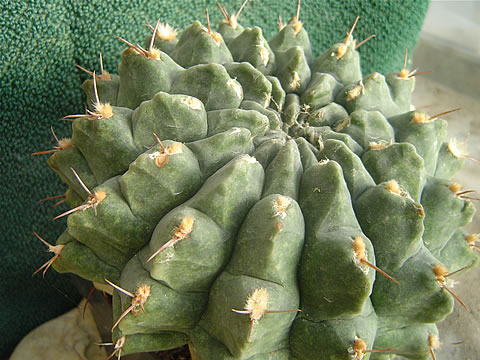
Gymnocalycium onychacanthum De Herdt
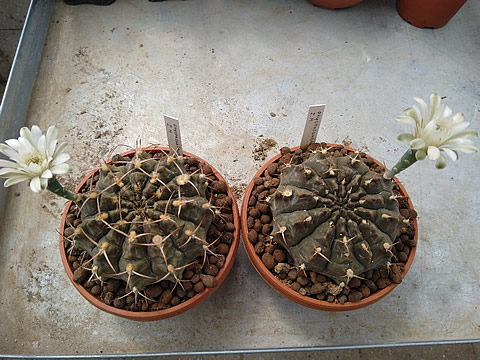
Gymnocalycium onychacanthum ex De Herdt Belgie
Gymn. onychacanthum – summary:
It is a form of Gymn. megatae, it ought to have after the description more marginal spines and more ribs. It is reported from the nature only the find HU 316 Paraguay, on the other hand this taxon is not hold too seriously. Seeds of Gymn. onychacanthum were offered by De Herdt in Belgium before about 20 years, the plants have really more ribs, epidermis is more graygreen, the protuberances are more sharp and they have two chin projections. However, they have not more spines and they do not reach the length of 3 cm but only 1 cm.
Gymnocalycium griseopallidum Backeberg
Backebergův popis z Kakteenlexikonu 167, 1965:
Tělo ploše kulaté, bělošedé, asi 6,5 cm v průměru a 3 cm vysoké, málo odnožující; žebra 7, s mnoha příčnými zářezy na bocích a mezi areolami (dosud jen u tohoto druhu), uprostřed 1,5 cm široká, 7 mm vysoká; trny 4 – 5 (- 6), až 1,5 cm dlouhé, černé, spodní víceméně přiléhající nebo víceméně pokřivené, později všechny šedé; květ?
Domovina: Bolívie, solné duny u San José, poblíž hranic s Paraguayí.
Backeberg uvedl jako nálezce pátera Hammerschmida, ale ve skutečnosti rostliny sbíral páter Klinger. Rostliny pak poslali importérské firmě Karlheinz Uhlig v Rommelshausenu v Německu. Backeberg s popisem spěchal, nepopsal tedy květ a s uváděnými černými trny se setkáme jen na obrázku v Kakteenlexikonu, kde je suchý import, který příliš nevypovídá. Naleziště asi po deseti letech navštívil páter Alfredo Lau, rostliny sbíral u vyschlého solného jezera za příšerného vedra, rostliny pak poslal ke zpracování britskému botanikovi Johnu Donaldovi. Lau se pak setkal s Klingerem a ten mu oznámil že páter Hammerschmid krátce předtím zemřel, protože se omylem napil kyseliny. No jo, žízeň je žízeň a bídný je někdy osud misijních služebníků v takových nehostinných a opuštěných tropických krajích.
Domnělá místa výskytu taxonu pozorovali rakouští gymnofilové, a při průzkumu stanovišť gymnokalycií podrodu Muscosemineum narazili u vojenské základny Fortin Ravelo roku 1995 na naleziště gymnokalycia, které označili jako Gymn anisitsii STO 986. Sám jsem od nich taková semena vysel a rostliny (viz obrázky) jsou skutečně formou Gymn anisitsii, i když vzdušnou čarou je toto stanoviště dost vzdálené od nalezišť typu Gymn anisitsii u města Concepcion. Po několika letech pozorování došli rakouští gymnofilové Till a Amerhauser k překvapivému závěru: Na základě nálezu původně označeného Gymn anisitsii STO 986 od Fortin Ravelo tuto rostlinu stanovili jako Gymn griseopallidum a hned taxon překombinovali na Gymn anisitsii var griseopallidum. Co je k takovému záměru přimělo již nebudeme zjišťovat. Po letech bádání a úvah nejen mé osoby, ale i dalších gymnofilů, se vracím k postavení Gymn. griseopallidum a Gymn. pseudomalacocarpus jako samostatných druhů a kombinace rakouských gymnofilů je zde brána v úvahu jako poněkud zavádějící a nepřijatelná.
Rostliny, které se u nás v minulosti jako Gymn griseopallidum pěstovaly (a stále pěstují), tedy pocházely převážně ze sběrů páterů Klingera a Hammerschmida prostřednictvím Uhliga a hlavně Alfreda Laua (Lau 368). Lau píše o nalezištích Gymn griseopallidum a Gymn pseudomalacocarpus v britském časopisu National Cactus and Succulent Journal roku 1971. Pro Gymn pseudomalacocarpus uvádí konkrétní naleziště u Taperas, místě zvaném Lourdes, kde se tehdy nacházelo několik neobydlených stavení, jako naleziště Gymn griseopallidum uvádí břehy suchého slaného jezera s několika slanými tůňkami, ale kde konkrétně se příliš mnoho nedozvíme, prý se zde vyskytuje i Gymn tudae, Lau jen uvádí vzdálenost nalezišť obou taxonů vzájemně od sebe asi 200 km, a věnuje se vyprávění o naprosto pekelném vedru s vysušujícími větry bičujícími tuto oblast, o následné žízni, o svých spolupracovnících z katolické misie, kteří pro Uhliga rostliny sbírali, protože sám byl také katolický kněz, atd. V té době tam neexistovaly silnice, na některá místa bylo možné cestovat jen po železnici, která tamtudy vedla, a nesmíme zapomenout, že tehdy žádné GPS neexistovaly. Pěkný článek o tom následně napsal dr Bohumil Schütz v tehdy ještě na blánách rozmnožovaném věstníku Gymnofil. Alfred Lau přednášel také v Praze, kde popisoval cestu za Gymn griseopallidum jako na konec civilizace, kdy musela jet za sebou dvě auta a razit si cestu trnitými křovisky. Rostliny jsou prý na nalezišti s červenohnědým odstínem celé epidermis, ale v kultuře krásně zelené. Zajímavé je také setkání s tapírem, asi hlídajícím kaktusy v tomto klidém kraji nedotčeném člověčí rukou.
Proto pokud chceme znát jak má správně vypadat Uhligovo – Backebergovo – Lauovo Gymn griseopallidum, musíme vycházet z jejich nálezů a následného potomstva, a nikoliv že jméno nasadíme na jinou rostlinu, kterou kdesi nalezneme. Dnes již musíme počítat s tím, že po 40 – 50 letech může dojít k zániku nalezišť vlivem civilizace jako jsou stavby plynovodů, ropovodů, silnic, těžba nerostů hnaná nezřízenou chamtivostí majitelů, kdy zahraniční firmy zvláště v Jižní Americe neberou nejmenší ohledy na přírodní prostředí a již vůbec ne na naše oblíbené kaktusy. Pokud nějaký taxon již nikdo nenajde, nelze z důvodu záchrany jména pro něj přidělit jiné rostliny z jiného stanoviště. Pak je lepší vést tuto rostlinu jako ztracenou v přírodě, a udržovat ji v čisté linii ve sbírkách co nejdelší dobu a řádně tyto oběti lidské činnosti a expanze alespoň zdokumentovat.
Po roce 2000 navštívil na několika výpravách řadu nalezišť Volker Schädlich z Německa, některé cesty podnikl s holandským gymnofilem Ludwigem Berchtem. Našli také rostliny Gymn anisitsii STO 986 u Fortin Ravelo, Volker Schädlich je označil svým polním číslem VoS 258 a vedl je původně jako spec. Poté u nich uváděl „Plants were described as Gymn anisitsii v griseopallidum“ (=rostliny byly popsány jako Gymn anisitsii v griseopallidum), později připsal „nemají nic společného se starými sběry Lau“.
Původně jsem měl v této práci uvedeno naleziště Gymn griseopallidum jako „Ravelo“ aniž bych se hlouběji zabýval proč tomu tak je. Až před pár lety začal vysévat gymna s VoS čísly gymnofil a velký milovník rostlin podrodu Muscosemineum Marek Grepl z Třebčína u Olomouce, kde má také přístup k tajnému nalezišti granodioritu, a již u malých semenáčků VoS 258 od Ravelo si povšimnul, že se nejedná o nám známé Gymn. griseopallidum. Také semenáčky STO 986 (=VoS 258) dávají již v prvním roce znát, že patří ke Gymn anisitsii. Díky Marku Greplovi a jeho cílevědomému výzkumnému úsilí jsem byl upozorněn na tento závažný problém, protože Gymn STO 986 vedu ve sbírce stále jako formu Gymn anisitsii zcela odděleně od klenotu jakým je Gymn griseopallidum sensu Backeberg.
Gymn griseopallidum je taxon v podstatě uniformního charakteru a tak po letech pěstování v našich sbírkách vypadá stejně tak jako v minulosti. Pokud budeme pátrat v literatuře, pěkná vyobrazení typického Gymn griseopallidum jsou v Schützově Monografii Gymnocalycium a v knížečce anglického gymnofila Putnama, jako dokumentaci přikládám fotografie Gymn griseopallidum Ferdinanda Plesníka z roku 1970 – tyto rostliny si velmi dobře pamatuji: v roce 1970 mi bylo 18 let a podařilo se mi od strýce Plesníka „vyškemrat“ jednu již pěknou rostlinku Gymn griseopallidum. Byla to moje první vzácnost, tehdy mezi gymnofily naprosto nevídaná. Jenomže ve své obavě o tento skvost jsem rostlinu řádně vymáchal v Metationu, a to byl začátek konce mé chlouby. Dodnes si to velice dobře pamatuji a mám z toho výčitky svědomí větší, než nesplněné sliby mé manželce (Eva= Gymn damsii ssp evae). K tomu snímky Gymn griseopallidum z dalších sbírek; všechna fota jasně dokumentují jak by mělo vypadat Gymn. griseopallidum. Již před 40 lety při pěstování ze semen měly semenáčky světle křídově zelenou barvu epidermis, která se u jiného gymnokalycia nevyskytuje. K tomu vynikají ještě světleji zbarvené plošky nad areolami s tmavším tečkováním. Toto juvenilní zbarvení se mění až po 3 – 5 letech na olivově zelenou až šedozelenou, bez fialových stínů jaké vykazují rostliny Gymn anisitsii STO 986 = VoS 258. Zde se musím vrátit k údaji v popisu Backeberga v Kakteenlexikonu: „s mnoha příčnými zářezy na bocích a mezi areolami (dosud jen u tohoto druhu)“. Dočkáme-li se velkých vyspělých jedinců, skutečně takové zářezy můžeme pozorovat. Zatímco u jiných taxonů tohoto příbuzenstva jsou zářezy viditelné včetně nejhlubších míst (tedy rozevřené, ne stisknuté), u Gymn griseopallidum jsou zářezy sevřené jako zvířecí tlamičky a zářezy přesahují z jednoho žebra do druhého. Volker Schädlich velice správně poznamenává, že Gymn griseopallidum a Gymn pseudomalacocarpus patří do příbuzenství Gymn. megatae.
Výzkumné práci v terénu se věnoval Volker Schädlich, který na svých několika cestách prozkoumal velkou část Paraguaye a jihovýchodní Bolívie, tedy oblasti kde se vyskytují zástupci podrodu Muscosemineum. Gymn griseopallidum pak nalezl rostliny označené jako VoS 15 z Cerro Chovoreca, Alto Paraguay (Horní Paraguay), v Paraguayi, v nadmořské výšce 200 m. Jde o typické Gymn griseopallidum, odnožující skupiny, s trny postavenýmy dva – dva do stran + 1 dolů směřující nejdelší. Při další cestě nalezl dvě další místa výskytu Gymn griseopallidum v Bolívii, a to VoS 575 Canada Abarva, Santa Cruz, 234 m, a VoS 579 jihozápadně od Roboré, Santa Cruz, 270 m, oba nálezy odpovídající habitem původním Gymn griseopallidum, jak je známe z nálezů svatých mužů z misie v Bolívii a Alfreda Laua. Jak můžeme pozorovat, oblast výskytu je daleko větší než byl náš původní předpoklad. K naší škodě a lítosti můžeme konstatovat, že stavba plynovodů či ropovodů značně stížila dosažitelnost nalezišť v bolivijsko-paraguayském pomezí, některá místa se stala prakticky nedostupnými.
Rozdíly mezi Gymn griseopallidum a Gymn pseudomalacocarpus: Pokud porovnáme květy Gymn. pseudomalacocarpus a Gymn. griseopallidum, zjistíme rozdíly a to dost podstatné. Gymn. pseudomalacocarpus má květy kratší a silnější, masitější, poměrně zavalité, kdežto květy Gymn. griseopallidum mají tenší trubku a jsou o mnoho delší. Gymn. pseudomalacocarpus má plody ovoidní až kulaté, Gymn. griseopallidum vřetenovité až protáhle kyjovité. Gymn. pseudomalacocarpus má v květuschopné velikosti epidermis hladkou a lesklou, Gymn. griseopallidum matnou. Gymn pseudomalacocarpus mívá jemné lilarůžové stíny na hranách hrbolců.
S popisem taxonu se objevil i popis Gymn. pseudomalacocarpus. Je zajímavé, že Gymn. griseopallidum se podařilo pěstovat ve sbírkách u nás a v sousedních státech a Gymn. pseudomalacocarpus bylo a stále je zde vzácností, ve Velké Británii tomu bylo právě naopak. Semenáčky Gymn griseopallidum jsou až do 5 let vždy křídově zelené a poznáme je tím od semenáčků Gymn. pseudomalacocarpus, které jsou vždy červenohnědé, ať je postavíte kde chcete. Pokud zčervená rostlina Gymn. griseopallidum, dává svému pěstiteli najevo úmysl posledního rozloučení.
Možná jsme přispěli k objasnění problematiky Gymn griseopallidum a Gymn pseudomalacocarpus. Přesto v obou taxonech zůstává jakési vnitřní tajemno, jakoby oba nádherné druhy pocházely z dávného rostlinného pravěku těchto suchých a horkých nedostupných končin.
Doplněk VII/2014: Příspěvek k objasnění historie Gymnocalycium griseopallidum a pseudomalacocarpus je založen hlavně na základě našich všeobecně známých a dostupných poznatků a informací, jejichž počátky sledujeme od nálezů pátera Alfreda Laua a jeho průvodců v bolivijsko – paraguayském pomezí Chaca, jako například páter Klinger a další katoličtí misionáři uhnízdivší se v této oblasti za účelem šíření víry mezi nebohý a na naše poměry omezený a tupý domorodý lid. Ovšem již nikdo nenalezne a neobjeví předcházející historii od vzniku popisů Backeberga a předtím, tedy nálezy pátera Hammerschmida a jeho zásilky firmě Uhlig v Rommelshausenu v Německu. Proč o tom píšu? Nikdo dodnes neví a asi se již nikdo nedozví a nebude schopen definovat, kde vlastně páter Hammerschmid sbíral původní Gymnocalycium griseopallidum a pseudomalacocarpus – a sbíral tyto rostliny vlastně osobně nebo mu je sbírali domorodí indiáni? Dá se silně pochybovat o tom, že Lau s Klingerem a dalšími pomocníky sbírali jejich griseopallida a pseudomalacocarpusy na stejných místech jako rostliny popsané předtím Backebergem.
Dnes víme, že jednotlivé populace Gymn. griseopallidum a pseudomalacocarpus a dalších forem těchto dvou druhů se omezují na velice malé mikroregiony, kde se rostliny míto od místa podstatně liší. To dosvědčují i nálezy světoznámého gymnofila Volkera Schädlicha z Drážďan, který se zaměřil speciálně na rostliny podrodu Muscosemineum z Paraguaye a z Bolívie. Jeho sběratelská čísla VoS 15 (Paraguay, Alto Paraguay, Cerro Chovoreca), VoS 54 (Bolívie, Santa Cruz, El Carmen west), VoS 325 (Bolívie, Santa Cruz, východně od Limoncito), VoS 575 (Bolívie, Santa Cruz, Canada Abaroa), VoS 579 (Bolívie, Santa Cruz, jihozápadně od Roboré) z příbuzenství dvou výše pojednávaných druhů dokazují mikroregionální výskyt jednotlivých forem Gymnocalycium griseopallidum a pseudomalacocarpus, avšak nejsou Lauovy Gymn. pseudomalacocarpus. Volker Schädlich tvrdí, že Gymnocalycium pseudomalacocarpus a griseopallidum jsou totožné taxony, s tím ovšem nemohu souhlasit. Volker Schädlich rozlišuje dva základní typy květů u tohoto okruhu rostlin: anisitsii (tenký) a megatae (tlustý). Griseopallidum podle známých nálezů Laua patří k anisitsii, zatímco pseudomalacocarpus k megatae. Takže podle samotného Volkera Schädlicha by mělo jít o dva podstatně rozdílné taxony se zcela odlišnými typy květů. Na jedné straně je třeba přiznat, že Volker Schädlich procestoval na mnoha expedicích dosud utajené kouty Paraguaye a věnoval tomu jistě nemalé prostředky, ovšem na druhé straně od časů Hammerschmida a Laua + Klingera z let 1963 – 1969, tedy před 50 lety, se situace v přírodních poměrech v Paraguayi naprosto podstatně změnila, „civilizace“ pokročila úžasným tempem na úkor přírody (pod heslem „Milujte se a množte se“, potažmo „Perte se a žerte se“, ale propagátory těchto hesel již nezajímá co budou všichni žrát – promiňte mi ten vulgarismus ale jinak to nevidím - , hlavně když bude dost lidí házet pesa do kasiček). Sám Volker Schädlich cituje ekologické statistiky, kdy za rok bylo vymýceno 300.000 hektarů původního lesního porostu. Čakenského pralesa, tedy domoviny rostlin podrodu Muscosemineum, a mnoho takových mikronalezišť již neexistuje. VoS sám uvádí jeho nálezy např. VoS 14a nebo VoS 37, které již nikdy opětovně nenalezl. Zkuste teď přemýšlet, kde nikdo z kaktusářů gymnofilů předtím nebyl, aspoň si to tak myslíme, kolik takových míst zůstalo v Paraguayi a Bolívii neobjeveno a zůstalo utajeno oku gymnofilů, a kterých je již zničených. Nechci moc hádat, ale jistě by to bylo pár desítek krásných rostlin z okruhu Gymnocalycium mihanovichii – friedrichii – anisitsii – megatae, nebo dokonce příbuzných tak senzačních objevů jako byly Gymnocalycium eurypleurum a obzvláště pak klenot Gymnocalycium paediophilum.
Pro celý gymnofilský svět je velkou škodou, že Volker Schädlich se zatím neodhodlal k žádnému popisu ani formy či variety a naopak tvrdívá, že „to a ono“ je to stejné atd. atd. Nikdy jsem nebyl příznivcem jakýchsi „neotypů“, kdy autor či pracovní skupina, jak se to rádo zove, podle nějakého svého nálezu definuje některý ze starých a ztracených taxonů na místech, kde původní autor mnohdy ani nebyl. Co je takových případů jenom v rodu Gymnocalycium! Například Gymnocalycium griseopallidum, multiflorum, stuckertii, pugionacanthum, rhodantherum, reductum, guanchinense, leptanthum, eytianum…….
Jde o libůstku autorů z posledních cca 25 let, kdy novodobý autor nebo kolektiv udělá z původního autora popisu nejapného blba a neználka, nebo dnes na slovo vzatý „odborník“ sedící v redakční radě rediguje příspěvky jiných autorů a cítíc se být osvícen aurou určuje, co bude druh nebo poddruh, nebo co je vhodné nebo nevhodné k uveřejnění. Takoví samoosvícenci jsou neštěstím pro jakýkoliv obor lidské činnosti nebo zájmový klub, když strkají nos do cizích produktů. Myslí si čtenář že to bylo za jezuitů nebo bolševiků? Kdepak! Je to dnes a hned tak to nepomine. Jeden chce něco popsat a druhý jej diriguje a komanduje co to bude.
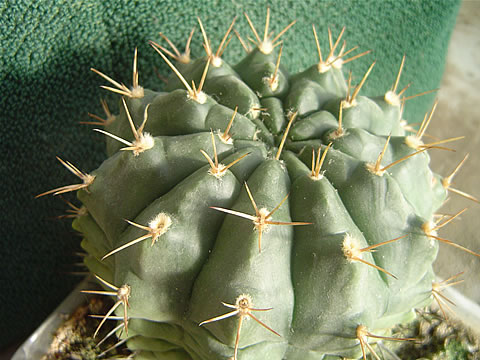
Gymn. griseopallidum
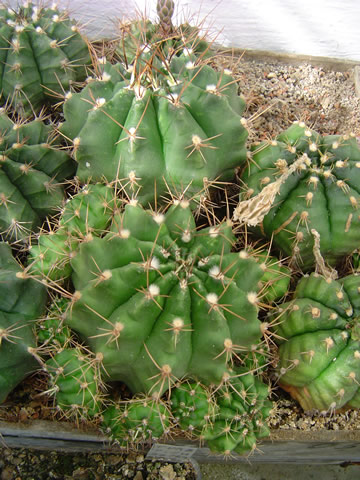
Gymn. anisitsii STO 986
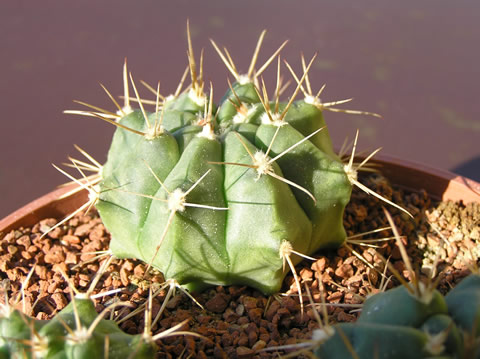
Gymn. griseopallidum L 368, foto Marek Grepl
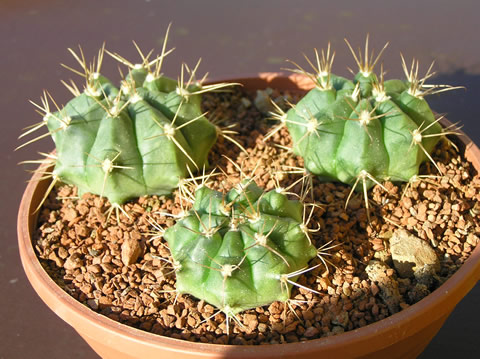
Gymn. griseopallidum L 368, 6leté semenáčky, foto Marek Grepl
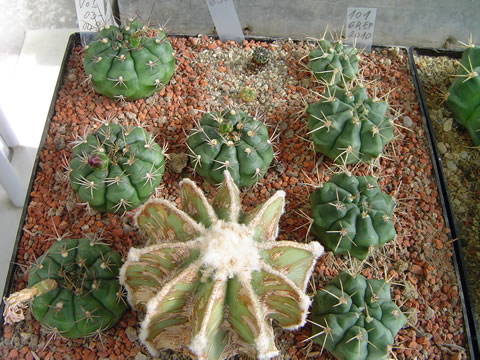
Gymn. griseopallidum v pravé řadě (right)
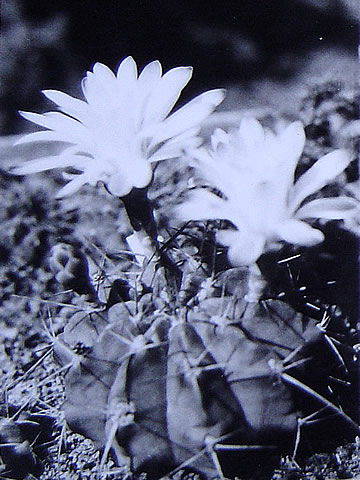
Gymn. griseopallidum z import semen, foto Ferdinand Plesník 1970
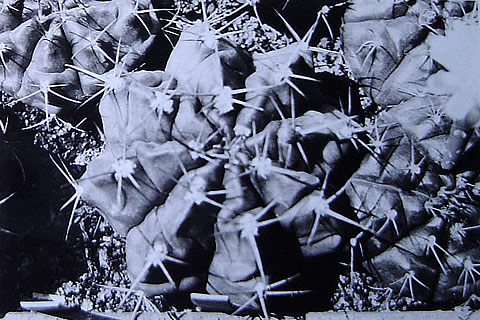
Gymn griseopallidum z import semen, foto Ferdinand Plesník 1970
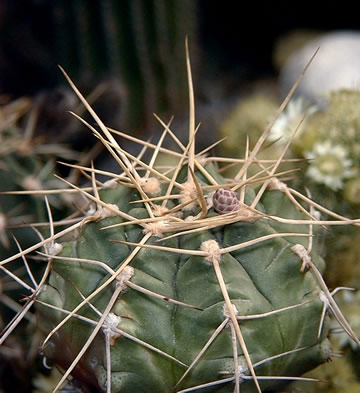
Gymn griseo-pallidum, foto Zvone Rovšek
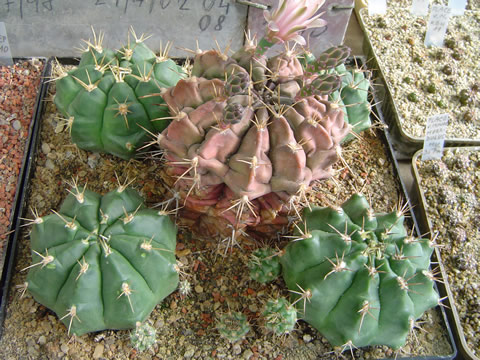
Gymn. griseopallidum
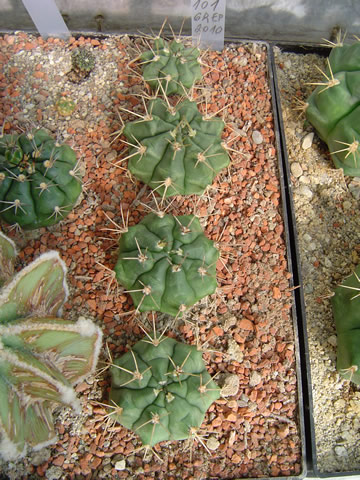
Semenáčky Gymn. griseopallidum
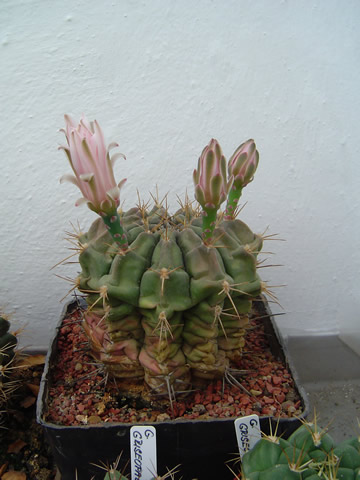
Květy Gymn. griseopallidum
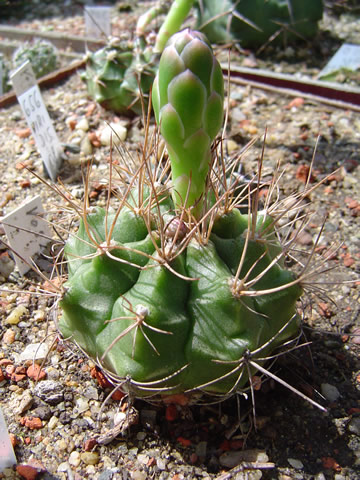
Gymnocalycium spec VoS 258
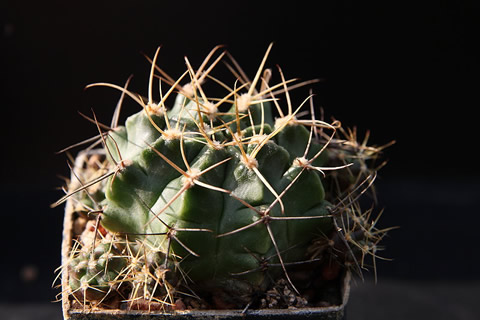
Gymn griseopallidum VoS 15 (48), foto Volker Schädlich
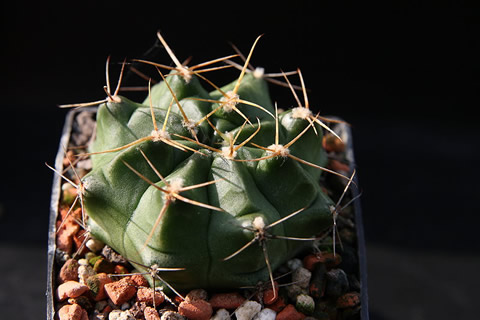
Gymn griseopallidum VoS 15 (50), foto Volker Schädlich
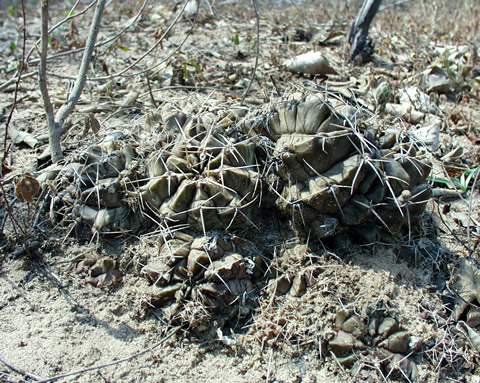
Gymn griseopallidum VoS 15 (50), foto Volker Schädlich
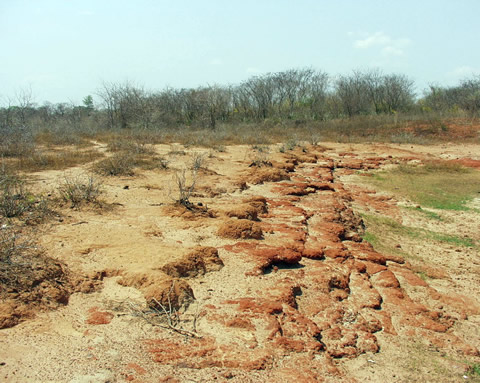
Naleziště VoS 15 Cerro Chovoreca, Paraguay, foto Volker Schädlich
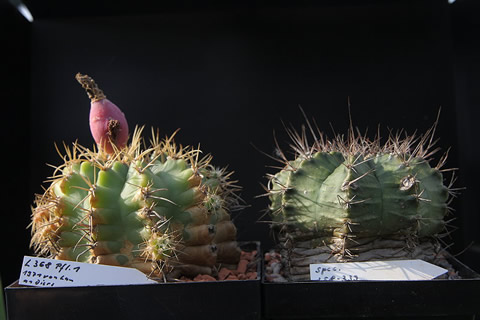
Srovnání Gymn griseopallidum L 368 a Gymn spec VoS 258 (=STO 986), foto Volker Schädlich
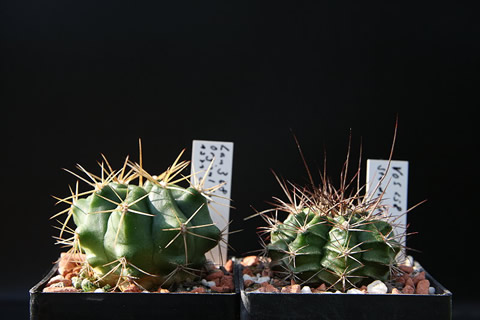
Srovnání Gymn griseopallidum L 368 a Gymn spec VoS 258 (STO 986 Fortin Ravelo), foto Volker Schädlich
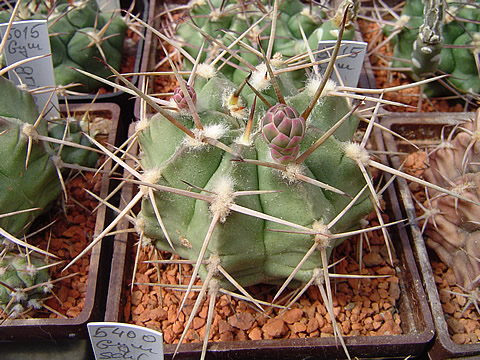
Gymnocalycium griseopallidum dlouhotrnná forma long spined form
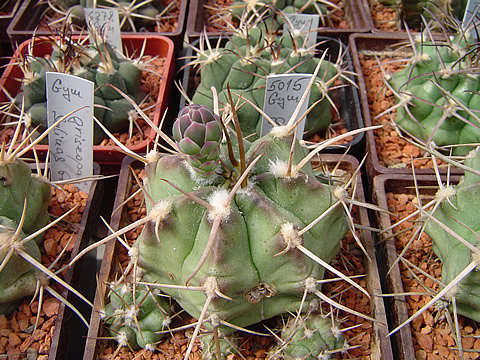
Gymnocalycium griseopallidum dlouhé trny long spines Gymn griseopallidum – English:
Backeberg‘ s description from the Kakteenlexikon 167, 1965:
Body flatly globular, whitishgray, ca 6,5 cm in diam and 3 cm high, little offsetting; Ribs 7, with many transverse cuts on sides and among areoles (only at this sort for the time being), 1,5 cm broad in the middle, 7 mm high; Spines 4-5 (-6), to 1,5 cm long, black, lower one more or less pressed to the body or more or less curved, all gray later; Flower?
Homeland: The salt dunes near San José, near the frontier of Paraguay.
Backeberg had mentioned like the founder the Father Hammerschmid, however, the Father Klinger had really collected the plants. They have sent the plants then to the importing firm of Karlheinz Uhlig in Rommelshausen in Germany. Backeberg had been in a hurry with the description, then he has not described flower, we can see mentioned black spines only in the picture in Kakteenlexikon where is dry import which is saying only little. The finding place was visited by the Father Alfred Lau after about 10 years, he collected the plants at the dry salt lake in the great heat, then he sent the plants to the British botanist John Donald for other observing. Lau met also Kliner and he has said him that the Father Hammerschmid died short time ago, because he had mistaken drunk acid.
The supposed finding places have been searched by the Austrian gymnofils and at the exploration of the finding places of the Muscosemineum gymnocalyciums they found one finding place of gymnocalycium at the army base Fortin Ravelo in 1995 which they marked as Gymn anisitsii STO 986. I have also sowed the seeds from them and the plants (see the picture) are really the form of gymn anisitsii even if this place is rather far as the crow flies off the finding places of the typical Gymn anisitsii at the town Concepcion. After several years of searching the Austrian gymnofils came to the surprising conclusion: On the base of the find originally marked Gymn anisitsii STO 986 from Fortin Ravelo they determined this plant like Gymn griseopallidum and they overcombined the taxon immediatelly to Gymn anisitsii var griseopallidum. We will not establish yet what was the reason to this conclusion. After the years of searching and consideration not only me but also some other gymnofils, I am back to the status of Gymn griseopallidum and Gymn pseudomalacocarpus as the independent sorts and the combination of the Austrian gymnofils is taken here like rather objectionable and inacceptable.
The plants which were grown in ours in the past as Gymn griseopallidum (and they are still grown) originated then mostly from the collects of the Fathers Hammerschmid and Klinger and Alfred Lau (L 368). Lau wrote about the finding places of Gymn griseopallidum and Gymn pseudomalacocarpus in the British journal „National Cactus and Succulent Journal“ in 1971. He mentioned the explicit finding place for Gymn pseudomalacocarpus at Taperas, in the place so-called Lourdes where there were several uninhabited buildings there, he mentioned like the finding place of Gymn griseopallidum the edges of the dry salt lake with several salt little pools – but where?: we gather not so much, it was said that also Gymn tudae grown there, Lau mentioned only the distance of the finding places of both taxa one from another about 200 km, and he wrote about the hell heat with the drying winds whipping those country, about following thirst, about his cooperators from the catholic mission who has collected plants for Uhlig because he had been also the catholic Father, etc. There were no roads at that time there, it has been possible to travel to some places only with a railway which run through that land, and we must not forget that no GPS existed at that time. Nice article about it was written by dr Bohumil Schütz in Gymnofil.
Alfred Lau had the speech also in Prague where he described the travelling for Gymn griseopallidum like to the end of the civilization, where two cars had to go one behind another and to thrust the way through the spiny bush. It was said the plants are on the finding place with redbrown shade of the whole epidermis but in the culture beautiful green. It was interesting also the meeting with the tapir probably watching cactus in this peace land untouched by man hand.
Therefore if we would like to know how it has to look correctly Uhlig´s – Backeberg´s – Lau´s Gymn griseopallidum we must mention out from their discoveries and from the following offspring, it is not possible to give the name to another plant which we had found anywhere. We must already count today with a posibility that some finding place becomes extinct after 40-50 years owing to the civilization like the gasline buildings, oillines, highways, mining, etc. If anybody can not find any taxon, it is not possible to give for it another plant from another finding place from the reason for the saving of the name. It is better to hold the plant like lost in the nature and to hold it in pure lines in collections long time what possible and to document properly the victims of the man doing and expansion.
Mr Volker Schädlich from Germany visited in several expeditions many finding places after the year 2000, he made several of them with the Dutch gymnofil Mr Ludwig Bercht. They also found the plants Gymn anisitsii (STO 986) at Fortin Ravelo, Volker Schädlich marked them with his field number VoS 258 and he held them originally like „spec“. Then he mentioned at them „Plants were described as Gymn anisitsii v griseopallidum“, he wrote more later „They have nothing to do with old collects of Lau“.
I have originally written in my work as to the genus Gymnocalycium on www.carciton.cz/kaktusy the finding place of Gymn griseopallidum like „Ravelo“ and I did not interest more why. The gymnofil and the great lover of Muscosemineum Gymnocalyciums Marek Grepl from Třebčín at Olomouc started to sow Gymnocalyciums with VoS numbers only several years before. He took notice of already little seedlings VoS 258 from Ravelo that they are not our known Gymn griseopallidum. Also the seedlings STO 986 (=VoS 258) give evidence already in the first year that they become to Gymn anisitsii. Thanks to Mr Marek grepl and to his tenacious searching effort I was drawn to this important problem because I have still Gymn STO 986 in my collection as the form of Gymn anisitsii quite separately off the gem like it is Gymn griseopallidum sensu Backeberg.
Gymn griseopallidum is the taxon with substantially uniform charakter and it looks the same after the years of growing in our collections like in the past. If we will search in the literature, nice picture of the typical Gymn griseopallidum are in Schütz´s Monography and in the book of the English gymnofil Mr Putnam, I add like a documentation the photos of Gymn griseopallidum taken by Ferdinand Plesník in 1970. I have remembered those plants very well: I was 18 years old in 1970 and I was succesful to wheedle one beautiful plant of Gymn griseopallidum from my uncle Ferdinand Plesník. It has been my first rarity not seen in gymno-collections of that time. However, I has been so anxious of it that I have washed properly the plant in Metation and it was the start of the end of my boast. The other photos document clearly how it had to look Gymn griseopallidum. Even before 40 years the seedlings growing from seeds had light chalky green colour of epidermis which is not usual on any other Gymnocalycium. And more, light coloured little areas above areoles with darker dots are also striking. This juvenile colouring becomes olivegreen to graygreen only after 3-5 years, without lilac or violet shades what have the plants Gymn anisitsii STO 986=VoS 258. I must go back to the data in the Backeberg´s description in Kakteenlexikon: „with many transverse cuts on sides and among areoles (only at this sort for the time being),…..“ If we live to see big mature plants, we can really search the cuts like this. While on the other taxa of this affinity the cuts are well remarkable including the deepest places (so opened, not pressed), the cuts on Gymn griseopallidum are pressed like animal mouths and cuts go from one rib over another. Mr Schädlich means very well that Gymn griseopallidum and Gymn pseudomalacocarpus belong to Gymn megatae affinity.
Mr Volker Schädlich has attended to the searching work in the field who has explored big part of Paraguay and southeast Bolivia, then the areas where the members of the subgenus Muscosemineum occur. He has found Gymn griseopallidum, the plants marked as VoS 15 from Cerro Chovoreca, Alto Paraguay, Paraguay, in altitude 200 m. It is the typical Gymn griseopallidum, offspringing groups, with spines arranged two – two to sides +1 downwards the longest. He has found other two places of Gymn griseopallidum occurence in one other expedition in Bolivia, VoS 575 Canada Abarva, Santa Cruz, 234 m, and VoS 579 southwest of Roboré, Santa Cruz, 270 m. Both finds accord with habit with the original Gymn griseopallidum how we know from the finds of the holy men from the mission in Bolivia and Alfred Lau. We can see that the area of the occurence is quite bigger than it had been our presupposition. We must say that the buildings of gaslines or oillines made the accessibility of the finding places much more difficult to our pity and sorrow in the bolivian-paraguayian frontier and some places became quite inaccessible.
If we compare the flowers of Gymn. pseudomalacocarpus and Gymn. griseopallidum, we can find the differences – and rather substantial. Gymn. pseudomalacocarpus has flowers shorter and stronger, fleshy, rather thick, while the flowers of Gymn. griseopallidum have slender tube and are much more longer. Gymn. pseudomalacocarpus has the fruit ovoid to globular, Gymn. griseopallidum spindle-like to elongated cudgel-like. Gymn. pseudomalacocarpus has the epidermis in age smooth and shiny, Gymn. griseopallidum dull. Gymn pseudomalacocarpus has fine lilacpink shades on the edges of the protuberances. Gymn. pseudomalacocarpus is much more sensitive in the culture and it is possible to recommend grafting.
The description of Gymn pseudomalacocarpus appeared at the same time in the same book of Backeberg. It is interesting that it has been succesful to grow Gymn griseopallidum in our collections and in the neighbouring states and Gymn pseudomalacocarpus was and it is still rarity here, in Great Britain it is quite on the contrary. The seedlings of Gymn griseopallidum are to 5 years of age always chalky green and we differentiate them from the seedlings of Gymn pseudomalacocarpus, which are always redbrown and you can have them staying where you want. When gymn griseopallidum becomes red, it gives to the grower the last good-bye.
Maybe we have contributed to make a clear more the problem round Gymn griseopallidum and Gymn pseudomalacocarpus. Nevertheless it is still in both taxa some inside mystery as if both beautiful sorts originated from the olden days plant of primeval ages of these dry and hot unaccessible areas.
Supplement VII/2014: The article clearing the history of Gymnocalycium griseopallidum and pseudomalacocarpus is based mainly on our generally known information, its start we can see since the discoveries of the father Alfred Lau and hid guides in the bolivian-paraguayan borderland of the Chaco, for example the father Klinger ant the other catholic missionaries. However, nobody will find the foregoing history since the descriptions of Backeberg yet, and also the foregoing history of the discoveries of the father Hammerschmid and his consignments to the firm of Uhlig in Rommelshausen in Germany. Why have I written about? Nobody has known for the time being and probably nobody will know and will be able to find where de facto the father Hammerschmid had collected the original Gymnocalycium griseopallidum and pseudomalacocarpus – and had he collected the plants alone or had the plants been collected by the native Indians? It is possible to be in doubt that Lau with Klinger and the other helpers had collected griseopallidum and pseudomalacocarpus on the same places like the plants described by Backeberg before.
We know today that single populations Gymnocalycium griseopallidum and pseudomalacocarpus and the other forms of these two sorts are limited to very little microregions where the plants are substantially different from a place to a place. The discoveries of the world-famous gymnofil Mr. Volker Schädlich from Dresden, Germany, give evidence of it. The field numbers of VoS 15 (Paraguay, Alto Paraguay, Cerro Chovoreca), VoS 54 (Bolívie, Santa Cruz, El Carmen west), VoS 325 (Bolívie, Santa Cruz, east of Limoncito), VoS 575 (Bolívie, Santa Cruz, Canada Abaroa), VoS 579 (Bolívie, Santa Cruz, jihozápadně od Roboré) from the affinity of two mentioned species prove the microregional occurence of the single forms of Gymnocalycium griseopallidum and pseudomalacocarpus, however, they are not the Lau´s Gymnocalycium pseudomalacocarpus. VoS means that Gymnocalycium pseudomalacocarpus and griseopallidum are identical species but I can not agree with this opinion. VoS differentiates two basal types of the flowers in the round of the plants: anisitsii (narrow) and megatae (thick). Griseopallidum after the known discoveries of Lau becomes to anisitsii, while pseudomalacocarpus to megatae. So after VoS alone they would have to be two different taxa with quite different types of the flower. On the one hand it is necessary to mention he has travelled in many expeditions up this time secret places of Paraguay and has given surely many money for it, however, on the other hand since the time of Hammerschmid and Lau + Klinger – the years 1963 – 1969, so 50 years before, the Paraguayan nature conditions quite substantially changed, the „civilization“ came ahead with great speed with the detriment of the nature. VoS mentioned his plants VoS 14a and VoS 37 which he has not found for the second time. Try now to think, where nobody of gymnofiles has not been before in Paraguay and Bolivia, how many places like those had remained to gymnofil eyes and which are now destroyed. I do not want to surmise too much but it would be surely several tens of beautiful plants of the round Gymnocalycium mihanovichii – friedrichii – anisitsii – megatae, or utterly related of so sensational discoveries as it has been Gymnocalycium eurypleurum and especially the gem Gymnocalycium paediophilum.
It is very pity for the whole gymnofil world that VoS has not resolved for the time being for no description of a form or a variety at least.
I am no friend of any „neotypes“, when an author or working group defined some old and last taxon after his discovery from the places where the original author has not ever been. We know many cases in the genus of Gymnocalycium! For example Gymnocalycium griseopallidum, multiflorum, stuckertii, pugionacanthum, rhodantherum, reductum, guanchinense, leptanthum, eytianum…….
It is a fad of the authors of the last cca 25 years if new author or group makes of the original author the inept idiot and ignorant, or „expert“ sitting in some editorial councillor determines what will be a species or subspecies and commands the authors of the articles.
Gymn griseopallidum Backbg in Deutsch:
Die Beschreibung von Backeberg in Kakteenlexikon 167, 1965:
K.plattrund, weiBgrau, ca. 6,5 cm durchm. Und 3 cm h. gesehen und schwach sprossend; Ri. 7, mehrfach quergefurcht an den Flanken bzw. zwischen den Ar. (bisher nur bei dieser Art so), in der Mitte ca. 1,5 cm br., 7 mm h.; St.4-5(-6), bis 1,5 cm lg., schwarz, untere +- anliegend oder +-verkrümmt, mittlere abstehend, später alle grau; Bl.? –Bolivien (Salzdünen bei San José, nahe der paraguayischen Grenze). Die durch die mehrfache Querfurchung gebildeten schwachen Hck. sind zur Trockenzeit +-blaBrötlich angehaucht. Durch seine fast kreidig helle Farbe von allen anderen Arten des Genus unterschieden (Koll. Uhlig, U 2179; von Pater Hammerschmid gefunden).
Backeberg erwähnte wie der Finder den Vater Hammerschmid aber der Vater Klinger hätte die Pflanzen tatsächlich gesammelt. Dann haben sie die Pflanzen an die Firma Uhlig in Rommelshausen in Deutschland geschickt. Backeberg eilente mit der Beschreibung, er hat nicht die Blüte beschrieben und die Abbildung in Kakteenlexikon, wo eine trockene Importpflanze ist, nicht viel ansagt, und wir können die angeführten schwarzen Stacheln nur an seine Importpflanze sehen. Der Vater Alfred Lau besuchte den Standort nach 5 Jahren, er sammelte die Pflanzen an den trockenen Saltsee in grosse Hitze, und dann er schickte die Pflanzen für Bearbeitung an Englisch Botaniker John Donald. Lau traff mit Klinger zusammen und er machte ihn bekannt daB der Vater Hammerschmid kürzen Zeit vorher zerstorben war weil er irrtümlich die Säure getrunken hätte. Alfred Lau trug auch in Prag vor, wo er die Reise für Gymn griseopallidum wie zu Ende von der Zivilisation erzählte; zwei Autos muBten ein hinter ein fahren und die Bahn brechen durch gedornte Gebüsche. Die Pflanzen waren mit rotbrauner Nuance auf ganze Epidermis auf dem Standort, aber schön grün in der Kultur.
Die Österreichische Gymnofreunde beobachtete die vermutem Standorten von der Art, und mit der Aufklärung von den Standorten den Muscosemineum Gymnokalycien sie findeten um die militär Basis Fortin Ravelo in 1995 einen Standort von Gymnocalycium, welche war wie Gymn. anisitsii STO 986 bezeichnet. Ich hate auch die Samen und die Pflanzen sind (siehe die Abbildungen) tatsächlich eine Form von Gymn anisitsii, trotzdem dieser Standort mit eine Luftlinie ganz entfernt von dem Typstandort von Gymn anisitsii um den Stadt Concepcion ist. Nach einige Jahre von Beobachtung kamen die Österreichische Gymnofreunde zu überraschendem AbschluB: Auf dem Grund von dem Fund ursprüngliche bezeichnete Gymn. anisitsii STO 986 aus Fortin Ravelo Sie setzte diese Pflanze wie Gymn griseopallidum fest und Sie überkombinierten taxon zu Gymn anisitsii var griseopallidum. Wir werden schon nicht ermitteln was Sie zu diesem AbschluB bewogen hat.
Nach Jahren von den Beobachtungen und Betrachtungen nicht nur von mir aber auch einige andere Gymnofreunden, ich kehre zu dem Zustand von Gymn griseopallidum und Gymn pseudomalacocarpus wie die selbständige Arten zurück und die Kombination von den Österreichischen Gymnofreunden wie mangelhaft und unannehmbar hier in der Betrachtung nimmt ist.
Die Pflanzen die in den Tschechischen Sammlungen gewachsen waren (und immer wachsen), kamen aus Sammel von den Väter Hammerschmid und Klinger und dann Lau her (L 368). Lau schriebe um die Standorten von Gymn griseopallidum und Gymn pseudomalacocarpus in der Englischen Zeitschrift National Cactus and Succulent Journal im 1971. Er führte für Gymn pseudomalacocarpus den standort um Taperas in dem Platz Lourdes genannt ein, wo einige unbewohnte Gebäude damals waren, er führte dann den Standort für Gymn griseopallidum das Ufer von den trockenen Saltsee mit einigen Salttümpeln ein, aber wo - wir nicht viel mehr kennen werden. Es gibt auch Gymn tudae dort. Lau schriebe daB die Entfernung zwischen beide Arten etwa 200 km ist, und er erzählte um höllische Hitze mit den trockenden Winden die peitschen diese Region, um den folgenden Durst, um seine Mitarbeiter aus der katolische Mission die die Pflanze für Uhlig gesammelte, usw. Es gab damals dort keine Strecke, das war Melich zu einige Plätze nur mit dem Zug der dadurch führte zu reisen, und wir müssen nicht vergessen daB keine GPS damals waren. Dr Schütz schriebe einen schönen Artikel in Tschechische Gymnofil.
Deshalb obwohl wir wissen wollen wie Uhligs – Backebergs – Laus Gymn griseopallidum richtig aussehen hat, müssen wir von seinen Funden und folgende Nachwelt ausgehen. Das ist unmöglich die Name zu eine andere Pflanze geben, die wir irgendwo gefunden haben. Heute müssen wir damit rechnen daB das möglich ist daB einige Standorte nach 40 – 50 Jahre zugrunde gehen, der Grund kann sein die Bauten von Gasleitung, Ölleitung, Strecke, die Mineralförderung, usw. Obwohl ein Sort oder Form nicht mehr findeten ist, ist das unmöglich für das andere Pflanzen aus einem anderen Standort zu zuteilen, wann wir nur dem Grund für eine Rettung einen Sort haben. Dann das ist besser die Pflanze wie verloren in der Natur zu haben mit der Erhaltung von der in der saubere Linie in den Sammlungen für lange zeit was möglich ist.
Nach dem Jahr 2000 besuchte Volker Schädlich aus Deutschland auf einigen Expeditionen, einige mit dem Gymnofreund Ludwig Bercht aus Niederland. Sie fanden auch die Pflanzen Gymn anisitsii STO 986 bei Fortin Ravelo, Volker Schädlich bezeichnete sie mit seine Feldnummer VoS 258 zuerst wie spec., er schriebe ein wenig später „Plants were described as Gymn anisitsii var griseopallidum“ (=Die Pflanze waren wie Gymn anisitsii var griseopallidum beschrieben), er zuschriebe später „sie haben nichts gemeinsam mit den alten Sammeln von Lau“.
Ich hatte in meiner Arbeit auf www.carciton.cz/kaktusy ursprünglich den Standort von Gymn griseopallidum wie „Ravelo“ ohne daB ich mich mit das befasste warum so das ist. Nur vor einigen Jahren begann der Gymnofreund und ein gross Liebhaber der Subgenus Muscosemineum Marek Grepl aus Třebčín bei Olmütz sein Aussaaten von Gymnokalycien mit den VoS Nummern zu machen, und er beachtete schon bei den kleinen Sämmlingen VoS 258 aus Ravelo daB sie nicht unsere bekannte Gymn griseopallidum sind. Auch die Sämmlinge STO 986 (=VoS 258) geben schon im erstem Jahr zu kennen daB sie zu Gymn anisitsii gehören. Ich war danke zu Marek Grepl und seiner zielbewuBten forschungen Austrengung an dieses wichtigen Problem aufmerksam gemacht, weil ich die Gymn STO 986 wie die Forme von Gymn anisitsii immer in meiner Sammlung habe, ganz abgeteilt von dem Edelstein wie Gymn griseopallidum sensu Backeberg ist.
Gymn griseopallidum ist Taxon wesentlich mit uniform Charakter und nach den Jahren in unseren Sammlungen identisch wie in der Vergangenheit aussieht. Wann wir in der Literatur forschen werden, die schöne Abbildungen den Typformen von Gymn griseopallidum sind in Schütz: Monografie rodu Gymnocalycium, in dem Büchlein von Englischem Gymnofreund Putnam, ich lege wie eine Dokumentation Fotos von Gymn griseopallidum von Ferdinand Plesník aus dem Jahr 1970 bei – ich erinnere mich die Pflanze sehr gut: ich war 18 Jahre alt in 1970 und ich gelange eine schöne grössere Pflanze von meinem Grossonkel Plesník zu locken. Das war meine erste Seltenheit, damals ganz ungesehn unter Gymnofreunden. Aber in meine Befürchtung um dieses Kleinod ich schwenkte die Pflanze ordentlich in Metation und das war der Anfang von der Ende meinen Stolz. Fotos von Gymn griseopallidum aus anderen Sammlungen dazu: alle Fotos dokumentieren klar wie Gymn griseopallidum aussehen hätte. Schon vor 40 Jahren die Zucht aus den Samen haben die Sämmlingen hellkreidegrüne Farbe von epidermis die nicht an andere Gymnokalycien ist. Das juvenile Gefarbung schillert nur nach 3 – 5 Jahren zu olivgrün bis (lebhaft oder matt)graugrün, ohne den violetten Schatten wie die Pflanzen von Gymn anisitsii STO 986 = VoS 258 haben. Ich muB hier an etwas aus Backebergs Beschreibung in Kakteenlexikon erinnern: „Ri. 7, mehrfach quergefurcht an den Flanken bzw. zwischen den Ar. (bisher nur bei dieser Art so)…..“ Obwohl wir grosse erwachsene Pflanzen abzuwarten, können wir wirklich diese Einschnitte sehen. Während die Einschnitte bei den anderen Taxa von der Verwandschaft auch mit der tiefsten Plätzen gut sichtbar sind (so aufschlagend, nicht drückend), sind die Einschnitte bei Gymn griseopallidum drückend wie tierische Mäuler und sie überragen aus einer Rippe in der andere. Volker Schädlich bemerkte sehr richtig daB die Gymn griseopallidum und Gymn pseudomalacocarpus zu der Verwandtschaft von Gymn megatae gehören.
Auch die Beschreibung von Gymn pseudomalacocarpus war publiziert mit Gymn griseopallidum. Das ist interessant daB Gymn griseopallidum in Zucht in unseren Sammlungen und in den benachbarten Ländern gelangen war und Gymn pseudomalacocarpus war und immer ist hier ein Seltenheit, in Grossbrittanien das ist ganz im Gegenteil.
Die Sämmlinge diesem Sort sind bis 5 Jahren immer kreidegrün und mehr, hell gefarbene Flächen mit dünkler Punktierung über Areolen sind noch hervorragend. Wir erkennen sie damit von den Sämmlingen von Gymn pseudomalacocarpus die immer rotbraun sind – und sie können sie stellen wo sie wollen. Gymn pseudomalacocarpus hat lilarosa gefarbenen Schatten auf den Kanten von dem Höcker. Wann die Pflanze von Gymn griseopallidum zu rote Farbe kommt, gibt es an seinen Züchter die Absicht den letzten Abschied merken zu lassen.
Volker Schädlich forschte grosse Teil von Paraguay und Südost von Bolivien durch, so den Regionen wo die Pflanzen Von Subgenus Muscosemineum wachsen. Er findete Gymn griseopallidum, die Pflanzen wie VoS 15 bezeichnete aus Cerro Chovoreca, Alto Paraguay (nördliche Region von Paraguay), in Paraguay im Altitude 200 m. Es gibt eine typische Gymn griseopallidum , wachsen in Gruppen, Dornenordnung 2 – 2 (zwei – zwei) + 1 nach unten längerest ist. Er findete auf eine andere Expedition zwei andere Standorte von Gymn griseopallidum in Bolivien – VoS 575 Canada Abaroa, Santa Cruz, 234 m, und VoS 579 südöstlich von Roboré, Santa Cruz, 270 m; beide Funde entsprechenden zu original Gymn griseopallidum, wie wir von den Funden von den Bolivischen hochheiligen Männer und Lau kennen. Wie wir sehen können , die Region von dem Vorkommen viel grösser ist als unsere ursprüngliche Voraussetzung war. Schade, daB der Ausbau der Ölleitung und Gasleitung viel beschwerliche Erreichung zu einigen Regionen machte, einige Plätze sind praktisch unerreichbar in dem Paraguay – Bolivianischen Grenzgebiet.
Möglicherweise haben wir bei der Aufklärung des Problems von Gymn griseopallidum und Gymn pseudomalacocarpus tragen. Trotzdem ein gewissere innere Geheimnis in beide Taxa wohnt, als ob beide schöne Arten aus der uralte Pflanzenurzeit von diesen trockenen und heiBen unbesteigbaren Gegenden abstammen.
Gymnocalycium pseudomalacocarpus Backeberg
Backebergův popis z Kakteenlexikonu 172, 1966:
Tělo ploše kulovité, 7 cm v průměru a 3 cm vysoké (pokud jsem je viděl), podobá se Malacocarpusu (Wigginsii), špinavě olivově zelené, v období klidu na vybledlých bocích žeber s načervenalým nádechem; žebra asi 11, příčně rýhovaná, s úzkými hrbolci s ostrými hranami, kolem areol zesílené; areoly asi 1,5 cm od sebe vzdálené, poněkud pohroužené.
Trny 3 – 5, směřující do stran a dolů, až 1,7 cm dlouhé, mírně ohnuté, nejspodnější nejsilnější, základny zesílené, vrchní pár někdy tenký a světlý, jinak všechny trny nažloutle hnědé; střední trn chybí.
Domovina: Bolívie, solné duny u San José, blízko paraguayských hranic.
U tohoto taxonu platí v podstatě to co bylo uvedeno u Gymn. anisitsii var. griseopallidum, oběma taxonům spíš slušelo postavení druhů. Rostliny našel páter Klinger, páter Hammerschmid je pak poslal firmě Uhlig do Německa. Bolivijští misionáři poslali do Německa několik zásilek rostlin, patrně si tak měli možnost přivydělat nějaký obnos na bídný život v těchto pustatinách. Asi deset let později naleziště navštívil Alfredo Lau, doprovázel jej páter Klinger, naleziště je na území indiánského kmene Ayoreo. Lau pak poslal rostliny anglickému botanikovi Johnu Donaldovi a ten taxon překombinoval na varietu Gymn. tudae. Schütz taxon považoval spíš za příbuzný Gymn. damsii, rakouští gymnofilové jej zase převedli pod Gymn. anisitsii.
Podle nich se má lišit od Gymn. anisitsii a Gymn. griseopallidum ploše kulovitým, v období sucha placatým tělem (které je podobné malacocarpusu), zato prý v květu, plodu a semenech jsou sotva nějaké rozdíly. To však neodpovídá skutečnosti, jak je uvedeno v dalším odstavci.
Domovina: Bolívie, Santa Cruz, u Naranjos, 235 m n.m.
Pokud porovnáme květy Gymn. pseudomalacocarpus a Gymn. griseopallidum, zjistíme rozdíly a dost podstatné. Gymn. pseudomalacocarpus má květy kratší a silnější, masitější, poměrně zavalité, kdežto květy Gymn. griseopallidum mají tenší trubku a jsou o mnoho delší. Gymn. pseudomalacocarpus má plody ovoidní až kulaté, Gymn. griseopallidum vřetenovité až protáhle kyjovité. Gymn. pseudomalacocarpus má v květuschopné velikosti epidermis hladkou a lesklou, Gymn. griseopallidum matnou. Gymn. pseudomalacocarpus je v kultuře daleko choulostivější a roubování lze doporučit.
Další nálezy:STO 1406; KK 509 San José; Lau 365 Lourdes Taperas.
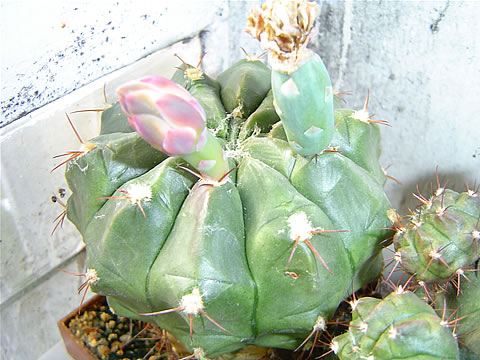
Gymn. pseudomalacocarpus
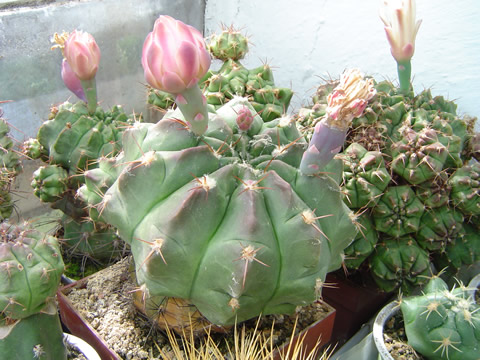
Gymn. pseudomalacocarpus
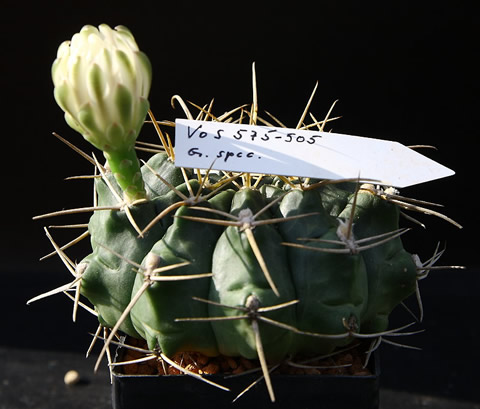
Gymnocalycium VoS 575, foto Volker Schädlich
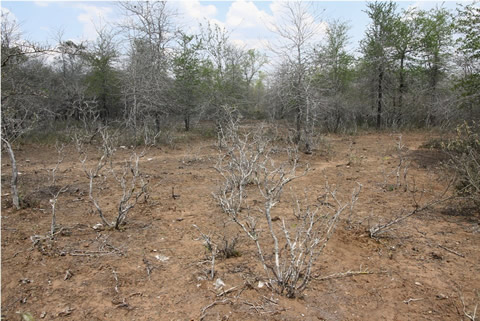
Naleziště VoS 575 Canada Abaroa, foto Volker Schädlich
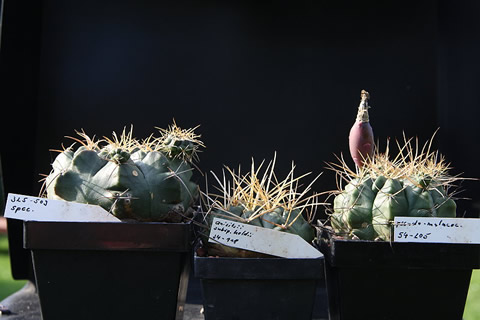
Srovnání Gymn VoS 325 vých od Limoncito, VoS 34 anisitsii ssp holdii a Gymn pseudomalacocarpus VoS 54 Bolívie,
západně od El Carmen, foto Volker Schädlich
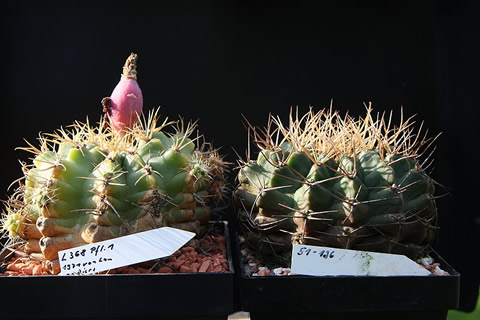
Srovnání Gymn griseopallidum L 368 a Gymn pseudomalacocarpus VoS 51 Bolivia, Santa Ana, foto Volker Schädlich
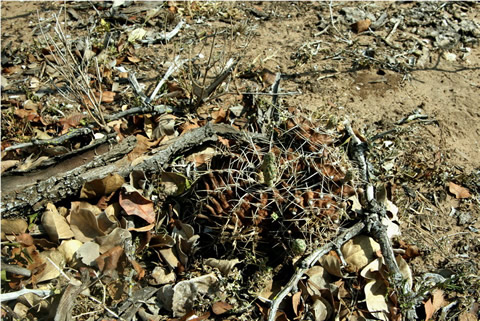
Gymnocalycium VoS 579 jihozápadně od Roboré, foto Volker Schädlich
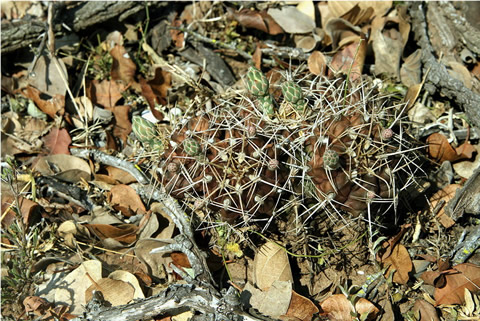
Gymnocalycium VoS 579 na nalezišti, foto Volker Schädlich Gymn. pseudomalacocarpus - summary:
They are valid substantially all notes mentioned at Gymn. anisitsii var. griseopallidum, however, both taxa would be better to be the independent sorts. The plants had been found by the father Klinger, then the father Hammerschmid had sent them to the firm of Uhlig in Germany. The father Alfredo Lau visited the finding place about ten years later, the father Klinger accompanied him, the place of the occurence is in the territory of the Ayoreo Indians. Then Lau has sent the plants to the British botanist John Donald who overcombined the taxon to the variety of Gymn. tudae. Schütz had held it rather for the relationship of Gymn. damsii, the Austrian gymnofils overcombined it under Gymn. anisitsii.
After them it ought to differ from var. anisitsii and var. griseopallidum with flatly globular, with disc-like body in dry season (which is similar to malacocarpus), however, it was said they are hardly any differences in flower, fruit and seeds.
If we compare the flowers of Gymn. pseudomalacocarpus and Gymn. griseopallidum, we can find the differences – and rather substantial. Gymn. pseudomalacocarpus has flowers shorter and stronger, fleshy, rather thickset, while the flowers of Gymn. griseopallidum have slender tube and are much more longer. Gymn. pseudomalacocarpus has the fruit ovoid to globular, Gymn. griseopallidum spindle-like to elongated cudgel-like. Gymn. pseudomalacocarpus has the epidermis in age smooth and shiny, Gymn. griseopallidum dull. Gymn. pseudomalacocarpus is much more sensitive in the culture and it is possible to recommend grafting.
Gymnocalycium hamatum Ritter
Kakteen in Südamerika II, 663, 1980
Tělo jednotlivé, šedozelené, v květuschopné velikosti 6 – 16 cm široké, v přírodě až 8 cm vysoké, s prohloubeným vrcholem, který není otrněný. Žebra 9 – 16, 10 – 15 mm vysoká a 15 – 25 mm široká, nad areolami vodorovné příčné zářezy, pod nimi zakulacené brady, které víceméně vystupují, vcelku jsou hrbolce zaoblené, nikoliv sekyrkovité, zářezy oddělující žebra klikaté. Areoly 5 – 8 mm dlouhé, 3 mm široké, s bělavou plstí na hrbolcích, od sebe vzdálené 10 – 18 mm.
Trny okrajové, šídlovité, poněkud zploštělé, směřující do stran, světle až středně hnědé, 5 – 7 – 9, směrem k tělu ohnuté, špičky více zahnuté až háčkovité, zejména spodní je většinou háčkovitý, ostatní uspořádány do párů, všechny 10 – 20 mm dlouhé.
Květy poměrně daleko na boku, 5 cm dlouhé, otevírající se jen na málo hodin, ale více dní po sobě, nevonící. Semeník 15 mm dlouhý, 9 mm silný, poněkud kuželovitý, olivově zelený, s rubínově hnědými, bíle lemovanými zakulacenými šupinami dlouhými 2 mm a širokými 3 – 4 mm. Nektarium trubkovité, 3 mm dlouhé, dobře kryté bazálním prstencem tyčinek. Horní část trubky nad naktariem šálkovitá, 12 mm dlouhá, uvnitř bílá, vně poněkud bělavá s přechodem do nahnědlé, s velkými nahnědlými tupými šupinami s červenou špičkou. Tyčinky bílé, nad nektariem prstenec jej uzavírající sestávající ze 4 – 5 mm dlouhých, vlnou pokrytých nitek, který přiléhá ke čnělce, nad tím asi 2 mm vysoká mezera, potom seskupení tyčinek, které je stále hustější a prodlužující se až na 10 mm. Ty jsou bez vlny a jsou ohnuté dovnitř. Prašníky šedočerné, podlouhle oválné, pyl krémový. Čnělka s bliznou uprostřed mezi prašníky, bez blizny 18 mm dlouhá, bílá, bliznové laloky asi 12, rozložené a vzhůru ohnuté, krémově zbarvené, 4 – 6 mm dlouhé. Vnitřní okvětní lístky 12 mm dlouhé, 2 – 3 mm široké, nahoře zastřižené, dole úzké, další se prodlužují až na 22 mm při šířce 5 – 6 mm, bílé s růžovým středním proužkem, více lineární, široce rozprostřené a dolů ohnuté.
Plod načervenalý, modře ojíněný, vřetenovitý, 25 – 30 mm silný, plodové maso šťavnaté, růžové. Semeno skolo kulovité, světle hnědé, 0,8 – 1 mm v průměru, jemně hustě hrbolcovité, hrbolce většinou vzájemně splývající a tím vzniká síťování s dolíčky, hilum bazální, podlouhle oválné, bílé.
Domovina: Palos Blancos, provincie Gran Chaco, Bolívie, FR 819.
Jak již vyplývá z popisu, taxon nalezl Friedrich Ritter (*1898, + 9.4.1989), žijící tehdy v Chile. Semena pak prodávala jeho sestra Hildegard Winter v Německu. Semena prý tenkrát dobře klíčila. Semena později nabízela i firma De Herdt, klíčivost také byla dobrá. Jen v kultuře jsou výsledky výsevů nepředpokládatelné, jednou semena vyklíčí, pak pět let nic. Osvědčilo se mi zralý plod z rostliny odstranit, semena ihned vyprat a ihned po oschnutí a možnosti manipulace s nimi šup s nimi do výsevní sklenice. Sklenici pak umístit na vrchní parapet do skleníku. Pokud zralý plod ponecháte na rostlině dva roky, pak již najdete v plodu vyklíčená semena. Ty je také možno pikýrovat, ale je to hrozná práce – ovšem i takovou piplačkou lze dosáhnout kýženého výsledku.
Páter Alfredo Lau také pozoroval a sbíral tento taxon v přírodě, rostliny pak poslal anglickému botanikovi Johnu Donaldovi ke zpracování, ten je pak označil Gymn. tudae var. viridis. Lau o popisu ještě nevěděl, a tak nálezy označil Lau 397 Paracari, Palos Blancos. Naleziště také navštívili Karel Kníže žijící v Limě v Peru, označil je jako KK 1099 Villazon, Ludwig Bercht LB 2366 Palos Blancos, a dr. Detlev Metzing M 111 Palos Blancos.
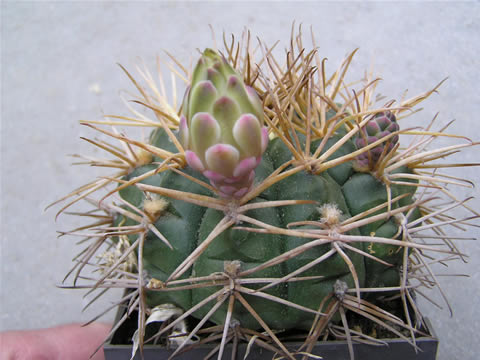
Gymnocalycium hamatum, foto Rudolf Frélich
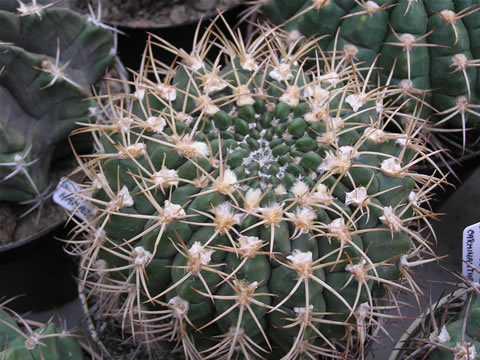
Gymnocalycium hamatum, foto Rudolf Frélich
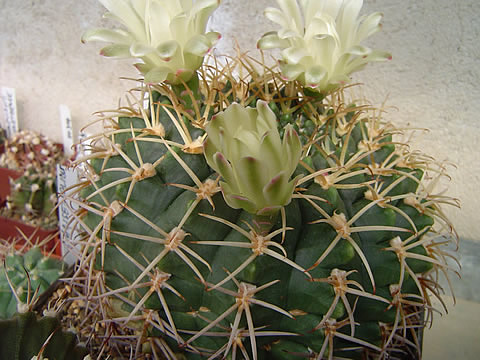
Gymnocalycium hamatum, sbírka ing Václav Jiránek CSc. Gymn. hamatum – summary:
How it is evident from the description, the taxon had been found by Friedrich Ritter (*1898 +9.4.1989) living at that time in Chile. Then his sister Hildegard Winter has sold the seeds in Germany. It was said that the seeds were sprouting also good and also offered by the firm of De Herdt later. Only in the culture the results of sowings are not sure, seeds sprout well one time, then five years nothing. It has well proved to me the ripe fruit to pick up from the plant, seeds to wash immediately and after some minute of drying to get them immediately into the sowing bottle. Then the bottle is placed to the highest position in the greenhouse. If you let the ripe fruit on the plant two years, you can find inside the fruit even sprouted seeds. They are possible also to repote but it is rather terrible work – however, it is possible to reach good result with the minute work like this.
The father Alfredo Lau has also researched the taxon in the nature, then he has sent the plants to the English botanist John Donald for observing, then he has marked them like Gymn. tudae var. viridis. Lau has not known the description else and so he has marked the finds Lau 397 Paracari, Palos Blancos. The finding place has been visited also by Karel Kníže living in Lima/Peru, and he has marked them as KK 1099 Villazon, and also by Ludwig Bercht – LB 2366 Palos Blancos, and by dr. Detlev Metzing – M 111 Palos Blancos.
|

